The Timeless Allure of Art Deco
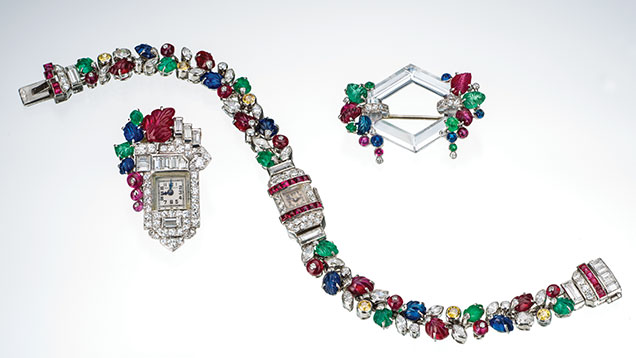
Autos, the radio, the telephone, and the motion picture became cultural fixtures. Skyscrapers sprung up in major cities. Jazz rang from speakeasies in Harlem. Charles Lindbergh made the first non-stop transatlantic flight. F. Scott Fitzgerald, Ernest Hemingway, Coco Chanel, Duke Ellington, Babe Ruth, and Charlie Chaplin commanded the cultural stage, their fame fueled by the rise of the mass media.
The role of women was also changing. Entering the workforce en masse during World War I, women gained the right to vote in 1920. Flappers – women who wore short dresses and short hair – were the new standard bearers of fashion, shocking society with their scandalous behavior. And they wanted a new style, something that was not like the frilly, traditional jewelry of the Edwardian and Art Nouveau eras.
Such was the setting for the arrival of Art Deco – a style that celebrated the machine age. Sleek ocean liners, streamlined trains, and towering skyscrapers were favorite images to express this: they symbolized prosperity, and progress, and the belief that technology was the cure for all ills.
The term “Art Deco” – the period lasted from the 1920s through the 1930s – came from Exposition Internationale des Arts Decoratifs et Industrials Modernes, an exhibition of decorative arts held in Paris in 1925. Jewelry was one of the featured items, and the judges selected geometric, linear pieces that celebrated modern industry.
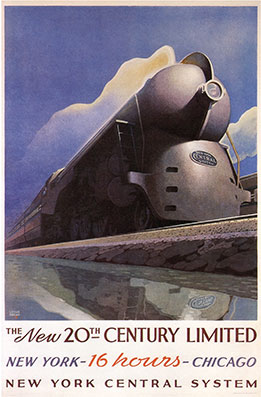
This Art Deco poster of a train conveys the power of technology and progress.
To give objects a futuristic look, Art Deco artists used vertical lines and geometric shapes (arcs, circles, triangles, squares, rectangles, etc.) in repetitive patterns. The Chrysler Building in Manhattan is a classic example of Art Deco architecture, and features a number of these design elements.
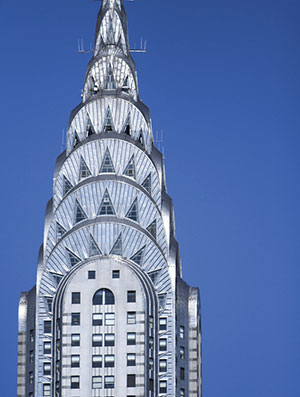
The Chrysler Building is an Art Deco masterpiece.
Jewelry designers were very much a part of the Art Deco movement. Departing from the organic curvilinear flourishes that belonged to the earlier movement, Art Nouveau, these designers embraced the vertical line and simple, repetitive geometric patterns. The purpose was to evoke elegance and sophistication.Art Deco jewelers used platinum and white gold, geometric shapes, and vivid color, contrasts to capture the spirit of the time. Diamond cuts in geometric shapes such as the baguette, triangle, trapeze, and half-moon became popular in Art Deco jewelry.

Art Deco chandelier earrings made with platinum, emeralds, sapphires, and diamonds.
Advances in stone cutting allowed jewelers to make complex pieces, like this platinum, sapphire, and diamond pendant/brooch shown below.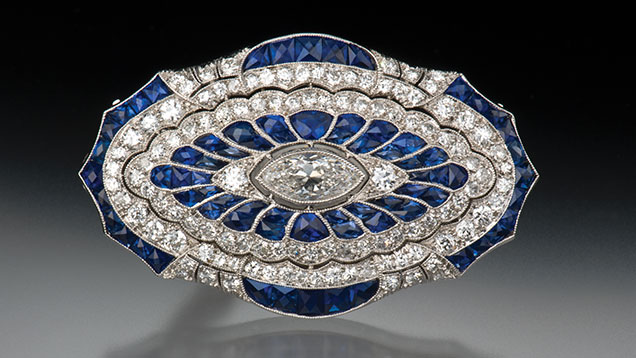
Brooch courtesy of Frank Goodman & Son, Los Angeles, CA.
A significant event in the Art Deco movement was discovery of King Tut’s tomb in 1922. Egypt’s art and architecture were exotic – fresh inspiration to artists schooled in old-world masters like Michelangelo and Rembrandt – and Art Deco practitioners readily borrowed motifs from it and other ancient civilizations that were being unearthed.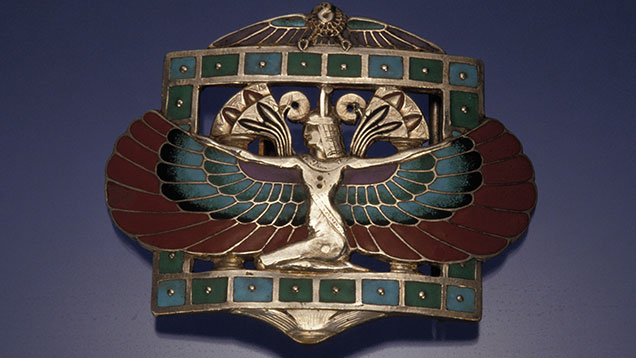
Buckle courtesy of Ginger Moro.
The timeless beauty of Art Deco and its promise of a bright future is what captivated the flappers – and it still speaks to us. F. Scott Fitzgerald poetically expressed this sentiment in The Great Gatsby: “Gatsby believed in the green light, the orgastic future that year by year recedes before us. It eluded us then, but that’s no matter—tomorrow we will run faster, stretch out our arms farther. . . So we beat on, boats against the current, borne back ceaselessly into the past.”Art Deco artists were simultaneously taking from the past and looking to the future. This was a unique combination, and created a distinctive style that gripped the imagination of the public.
Tips for designing and selling Art Deco jewelry
- Art Deco was defined by the vertical line and repetitive geometric shapes. Use them to design Deco-inspired pieces. Let your customers know how these design elements create a sleek and sophisticated look.
- Art Deco jewelry often has dramatic color contrasts. Perhaps this was an expression of optimism towards the future, or a welcome change from the pastels of the Art Nouveau era and the typical absence of colored stones in most Edwardian-Era jewelry. Use of bold, contrasting colored gemstones or enamel in your pieces can evoke the Art Deco style.
- Art Deco artists freely borrowed design elements from ancient cultures. The contrast of the modern and the old made for fascinating works. Customers are likely to find this interesting. You can also incorporate ancient motifs to add pizzazz to your designs.



